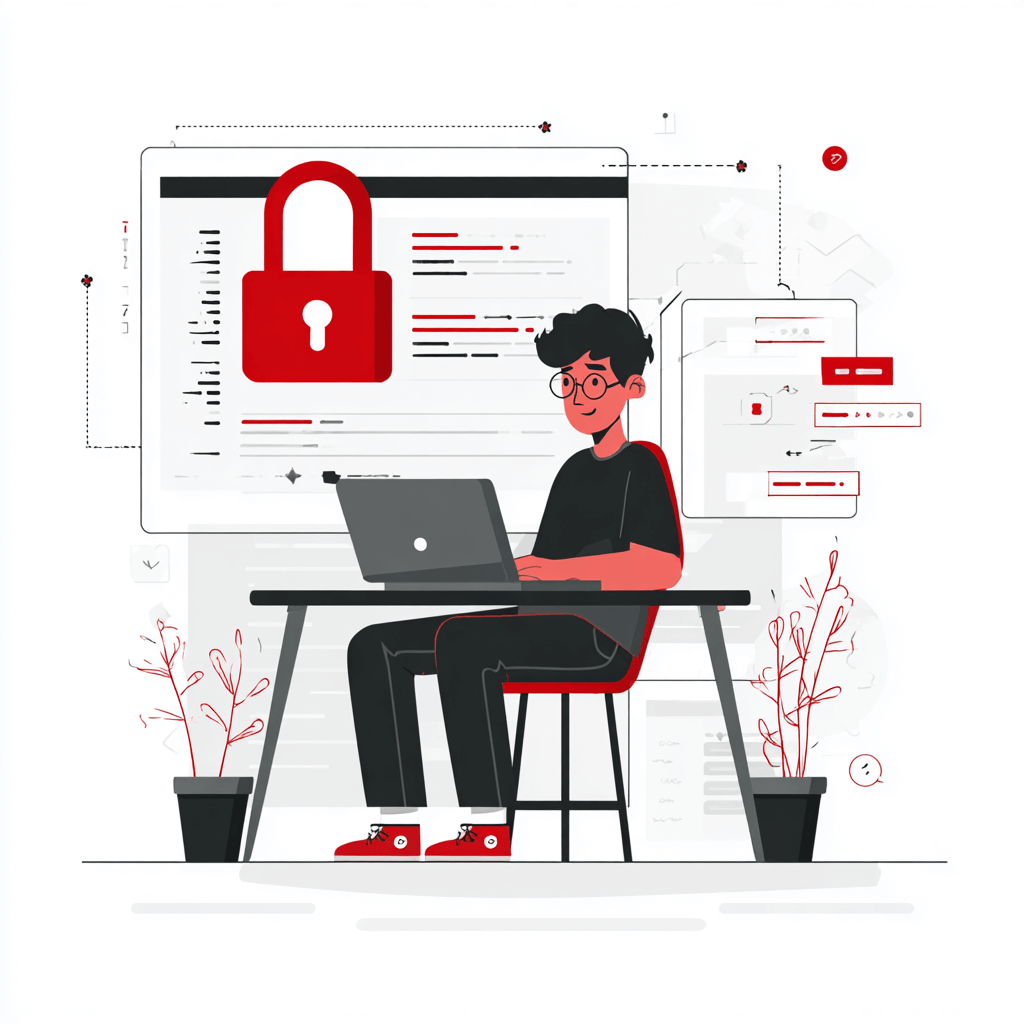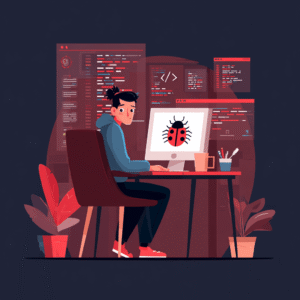
Did you know that 43% of cyberattacks target small businesses?
Yet, most of them assume attackers only go after big corporations. The truth is, whether you’re building a startup website, an eCommerce platform, or a SaaS product, your code is a potential target the moment it goes live.
When it comes to web development security, the stakes are higher than ever in 2025. Hackers no longer just exploit outdated software—they use AI-driven attacks, automated bots, and even supply-chain vulnerabilities to find their way in.
Here’s the catch: security isn’t a one-time checklist item you tick off after launch. It’s not just about installing SSL or running an antivirus. Instead, security must be built into every stage of web development—from writing your first line of code to deploying, updating, and monitoring your application.
Think of it this way:
- A website without proper security is like leaving your front door unlocked.
- Security that isn’t maintained is like locking the door once but leaving the window open forever.
This guide will walk you through 15 practical, developer-focused tips for web development security in 2025—so you can safeguard your apps, protect user data, and stay ahead of modern cyber threats.
Web Development Security in 2025

In 2025, keeping websites and apps secure has become more challenging than ever. Hackers are no longer just trying simple tricks to break in—they’re targeting the tools and plugins developers use every day. This is known as a supply-chain attack, where one weak link in a third-party library or update can put an entire project at risk.
At the same time, AI-driven attacks are on the rise. Cybercriminals now use artificial intelligence to scan for vulnerabilities, guess passwords faster, and even create fake login pages that look almost real. This makes it harder for both businesses and users to spot danger in time.
That’s why web development security in 2025 requires more than just installing SSL or running a scan once in a while. Developers need to follow web development security best practices consistently and use a clear security checklist to stay protected.
In simple words:
- Attacks are smarter and faster than before.
- Outdated or careless coding can open big security gaps.
- Security must be a continuous part of the development process.
By understanding these modern threats, developers can build safer websites and applications that protect both businesses and users.
15 Critical Web Development Security Tips for 2025
When it comes to building modern websites and applications, developers can’t afford to treat security as an afterthought. Attackers are faster, smarter, and more persistent, which is why following clear website security best practices is the only way to stay ahead.
Below is a web security checklist with 15 actionable steps you can apply right away to ensure secure web development in 2025.
Authentication & Authorization
- Implement passwordless login or MFA by default
Use modern authentication tools like Auth0, Firebase Auth, or Keycloak. Multi-factor authentication (MFA) significantly reduces account hijacking risks. - Session timeout best practices
Configure auto-logouts after inactivity (e.g., 15–30 minutes). This prevents attackers from abusing abandoned sessions. - Limit login attempts & add CAPTCHA
Throttle brute-force attacks by locking accounts or adding CAPTCHA after multiple failed attempts.
Input & Data Validation
- Use parameterized queries or ORM
Avoid raw SQL queries. Instead, use prepared statements or ORMs to prevent SQL injection, one of the most common web vulnerabilities. - Sanitize inputs with libraries
For example, use DOMPurify in the frontend to block malicious scripts and prevent cross-site scripting (XSS) attacks. - Validate both client-side and server-side
Client-side validation improves user experience, but always recheck inputs on the server for true protection.
Data Protection
- Use TLS 1.3, not just HTTPS
Older protocols are easier to break. Ensure your server enforces TLS 1.3 for secure communication.
- Hash passwords with bcrypt or Argon2
Never use outdated hashing algorithms like MD5 or SHA1. Modern algorithms provide resistance against brute-force cracking. - Store secrets in vaults
Protect API keys and credentials with HashiCorp Vault, AWS Secrets Manager, or environment variables—not in your codebase.
Secure Coding & Deployment
- Use Content Security Policy (CSP)
Configure CSP headers to restrict external scripts and block inline JavaScript. This adds a strong defense against XSS. - Turn off detailed error messages in production
Show users generic error messages, but log technical details privately for debugging. Don’t give hackers a roadmap. - Automate dependency updates
Use tools like Dependabot, npm audit, or Snyk to detect and patch vulnerabilities in third-party libraries quickly.
Infrastructure & Monitoring
- Enable a Web Application Firewall (WAF)
Services like AWS WAF, Cloudflare WAF, or Nginx ModSecurity help filter malicious traffic before it reaches your app. - Run automated security scans in CI/CD pipelines
Integrate tools such as OWASP ZAP, SonarQube, or GitHub CodeQL into your build process to catch vulnerabilities early. - Set up real-time alerts
Use monitoring tools to trigger alerts (via Slack, email, or dashboards) for unusual activity, such as repeated failed logins or high error rates.
Common Mistakes Developers Make (and How to Fix Them)

Even with the best intentions, developers often leave behind gaps that attackers can exploit. Understanding these pitfalls is just as important as following best practices. Below are three common mistakes in web development security—and how to fix them before they cause trouble.
1. Using eval() in JavaScript
- ❌ The problem: eval() executes code from a string, which means malicious input can run directly on your site.
- ✅ The fix: Replace eval() with safer alternatives like JSON.parse() for data or trusted libraries for logic. This prevents attackers from injecting and executing harmful scripts.
2. Leaving Default Admin Credentials
- ❌ The problem: Many CMS platforms, databases, or servers come with default usernames and passwords (like admin/admin). Attackers know these and exploit them quickly.
- ✅ The fix: Always change default credentials during setup. Use strong, unique passwords and enable two-factor authentication for admin accounts.
3. Storing API Keys in GitHub
- ❌ The problem: Hardcoding API keys or secrets in your repository (even private ones) risks exposure. Once leaked, attackers can misuse services, costing money or data.
- ✅ The fix: Add keys to environment variables or use secret management tools like AWS Secrets Manager or HashiCorp Vault. Also, use a .gitignore file to ensure sensitive files never get committed.
Tools & Resources for Developers
Securing a web application doesn’t have to mean starting from scratch. There are plenty of powerful tools that can help developers follow web development security best practices and catch issues early:
- Burp Suite / OWASP ZAP → Use these penetration testing tools to simulate attacks and identify vulnerabilities in your application before hackers do.
- Helmet.js (Node.js) → A lightweight middleware that automatically sets secure HTTP headers to block common exploits.
- ESLint security plugins → Extend your code linting setup with security-focused rules to catch unsafe coding patterns during development.
These tools make it easier to build a reliable web security checklist into your workflow without adding unnecessary overhead.
Future of Web Security
The future of secure web development in 2025 and beyond will look very different from today. Two major shifts are already underway:
- Quantum-safe encryption → With quantum computing on the horizon, current encryption methods like RSA could become vulnerable. NIST is already standardizing quantum-safe algorithms to ensure long-term data protection.
- AI-driven anomaly detection → Security systems powered by AI can learn user behavior patterns and automatically flag unusual activities, catching threats that humans or traditional tools might miss.
These trends show that web application security tips will continue to evolve—and developers must stay ahead by adapting their practices.
Conclusion
Building secure websites and applications isn’t about adding a massive security layer at the end. It’s about taking small, consistent steps throughout the development process.
Simple actions—like enabling CSP, hashing passwords with bcrypt, or automating dependency updates—may feel minor, but together they create a strong defense.
In short, adopting a “security-first mindset” ensures that web development security is not just a feature, but a foundation of everything you build.
FAQs: Web Development Security in 2025
1. Is SSL enough to protect my website?
No. While SSL (or HTTPS) is a must-have, it only secures data in transit. To truly protect your site, you also need strong security headers, a Web Application Firewall (WAF), and secure coding practices. Think of SSL as locking the front door—it’s helpful, but it won’t stop someone from breaking a window.
2. How can I test my website security for free?
You don’t need expensive tools to get started. Free resources like OWASP ZAP (for penetration testing) and SecurityHeaders.com (to check header configurations) can quickly identify gaps. Regular testing is one of the best tips to prevent website hacking.
3. What’s the easiest quick fix for beginners?
If you’re new to web development security, start simple:
- Enable HTTPS across your site.
- Keep frameworks and libraries auto-updated.
- Use Helmet.js (for Node.js apps) to add secure HTTP headers.
These quick wins form the foundation of secure coding guidelines for developers.
4. How to secure web applications in 2025?
Security in 2025 is all about layered defense. That means using MFA for logins, validating all inputs, encrypting sensitive data, and monitoring applications in real time. Combining these best practices for web development security makes it much harder for attackers to succeed.
5. Why is web application security so important?
The importance of web application security goes beyond preventing hacks—it’s about protecting user data, maintaining trust, and avoiding costly downtime. A single breach can damage reputation, result in fines, and cause long-term business loss.
6. What are the most common security mistakes to avoid?
Some classic security mistakes to avoid in web development include:
- Leaving default admin credentials.
- Hardcoding API keys in repositories.
- Using outdated hashing algorithms.
- Not validating inputs on the server side.
Fixing these simple issues can drastically improve the security of your application.